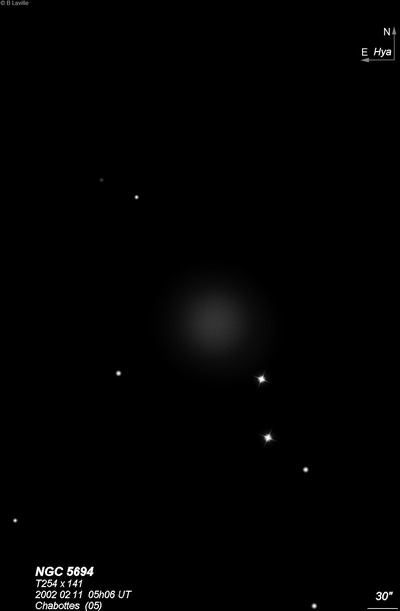
William Herschel discovered NGC 5694 = H II-196 = h3576 on 22 May 1784 (sweep 223) and recorded "pB, S, r, nearly R and bM. It forms an arch, or very bright obtuse triangle with two stars very near and preceding it. The arch is concave to the northeast and the two stars with the nebula are all within 5'." John Herschel called the cluster "vB; pL; R; psbM; 1st class; 20"; r; several stars near." His RA in the Cape Catalogue was 35 seconds too large. Heinrich d'Arrest (who noticed the error) and Engelhardt measured accurate micrometric positions.
Announced as a globular cluster in the 1934 paper "Object NGC 5694 a Distant Globular Star Cluster" by Lampland and Clyde Tombaugh (1932AN....246..171L) at Lowell Observatory, based on photographic plates taken with the 13" Lowell telescope and followed up with the 42-inch reflector. The large reflector clearly showed this was a condensed globular cluster.
200/250mm - 8" (6/27/81): fairly faint, small, bright core.
400/500mm - 17.5" (4/13/96): moderately bright but compact globular of 2' diameter with a round, symmetrical appearance. Contains a 40" well defined core that increases to a nearly stellar nucleus. There is no evident resolution in the halo. Situated at the end of a string of brighter stars with two mag 11 stars close SSW.
17.5" (5/10/86): this is a small globular cluster with a very small bright core and a fainter outer halo. Very mottled and grainy but no resolution. A pair of mag 11 stars oriented N-S are off the SW side about 1.5' and 2.5' from the center.
Notes by Steve Gottlieb